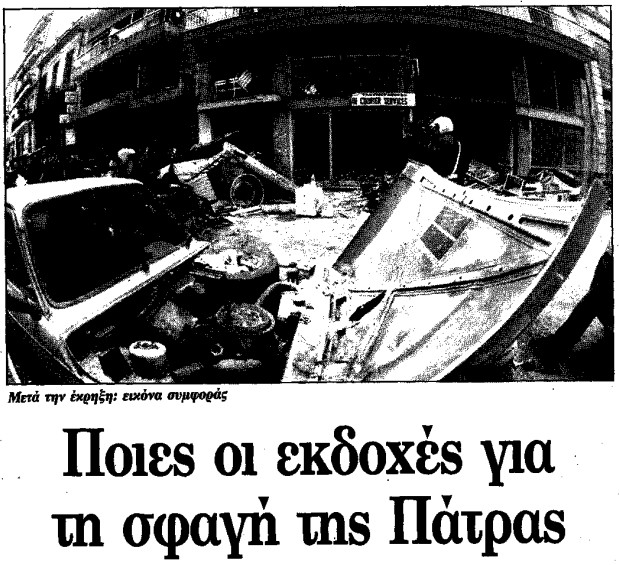On the morning of Friday, April 19, 1991, at exactly 10:50 a.m., a massive explosion tore through the ground floor of an apartment building at 12 Votsi Street, right in the heart of Patras. The blast, of staggering force, sent shockwaves not only through the city but across the entire nation.
The explosion struck hardest at the neighboring offices of the courier company ACS, which was fully operational at the time and staffed with employees.
According to TO VIMA's April 21, 1991, report:
“The explosion claimed the lives of the bomber and six others. Seven more people were injured, two critically. Four vehicles were destroyed, and buildings within a 200-meter radius suffered damage.”
Among the victims were Georgia Verra (23), Dimitris Seitanidis (24), Olga Strangalinou (23), and Giannis Kafkas (23)—all employees of ACS. Giorgos Papasotiroglou (50), a customer at the time, and Vasilis Kyriakopoulos (47), a civil engineer walking past the building, were also killed in the blast.
Eyewitness Accounts
Speaking to TA NEA on April 20, 1991, eyewitness Nikos Konstantopoulos recalled:
“I heard a deafening noise that drowned everything out. The street was filled with shattered glass and overturned cars.”
Another witness, K. Bogonikolos, added:
“It all happened so suddenly—everything was destroyed. We ran inside to rescue the kids who were trapped in the office, buried under rubble…”
The Investigation: A Race Against Time
The explosion’s sheer force had vaporized the bomber’s body, posing a major challenge for investigators trying to identify him.
As reported by TO VIMA on April 21, 1991:
“All hopes for unraveling the mystery now rest on a single Timberland shoe and a fragment of a denim shirt—the only traceable remnants left behind.”
Authorities believed these items belonged to the unknown bomber, whose body was obliterated by the blast.
“Only the bomber’s right leg, severed at the thigh, and a portion of his scalp were recovered—enough to confirm he was a young man with short brown hair.”
What Happened That Day?
In the early 1990s, Greece was still facing threats from homegrown terrorist groups like 17 November. At first, investigators suspected domestic terrorism. But soon, the evidence pointed elsewhere.
Further inquiries led authorities to a Palestinian terrorist group, whose intended target was the British consulate in Patras—located just a short distance from where the bomb ultimately exploded.
As TO VIMA reported on April 28, 1991:
“Palestinians Amet Hasikeh and Asar Al-Nobani arrived that Friday morning to plant a bomb at the building housing the British consulate and a shipping company. But when they got there, the area was busy with people. The bomb had a 12-minute timer, and they were running out of time.”
“Hasikeh entered a nearby apartment building—right next to the courier company—while Al-Nobani stayed outside to keep watch. According to police assessments, Hasikeh likely tried to reset or disarm the bomb at the last minute. During that attempt, something went wrong—the bomb detonated.”
A Catastrophe Narrowly Contained
Had the bomb reached its intended target—the busy consulate building—the death toll could have been catastrophic. Police officers later noted that the consulate sits next to a major bus stop, frequented daily by large crowds.
Instead, the failed operation caused immense tragedy at a different location, killing innocent civilians and leaving lasting trauma in its wake.
The Aftermath
In the following months, authorities arrested three accomplices of the deceased bomber. By December 1995, after a lengthy legal process, they were convicted in a second trial:
Asar Al-Nobani and Baikarat Khalil were sentenced to 25 years in prison.
Awad Khalil received a three-year sentence.
The 1991 bombing remains one of the most devastating terrorist attacks in Greece’s modern history—a brutal reminder of the human cost of extremism and the random nature of violence. Though decades have passed, the memory of that day in Patras lives on in the collective memory of a nation.












